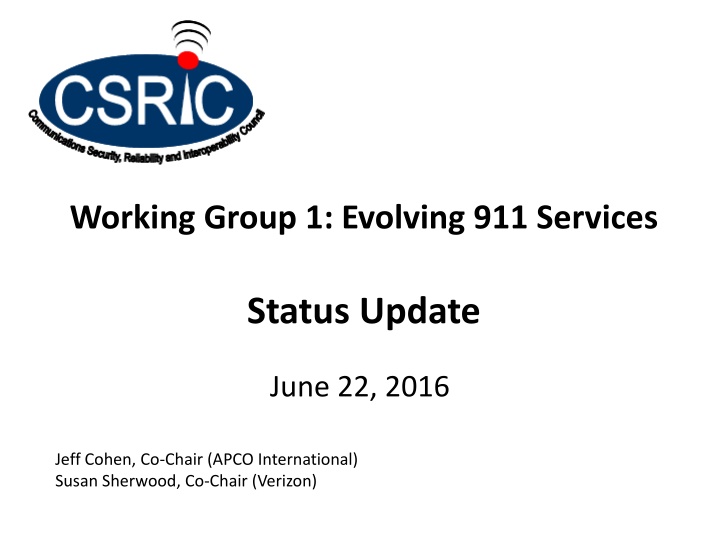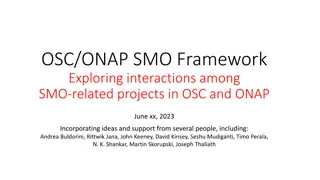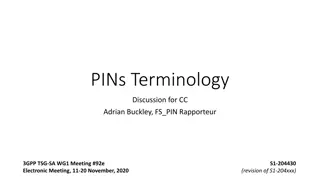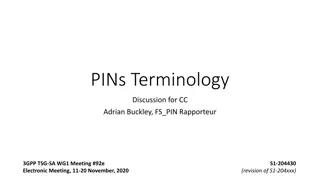
Evolving 911 Services Task 2 Report & Recommendations Update
Stay updated on the progress of Working Group 1 in evolving 911 services through their bi-weekly meetings to complete Task 2 report and recommendations. Explore the study and recommendations on location-based routing for voice 911 calls from wireless devices, including CMRS, IP-based, and OTT applications. Understand the pros and cons of various location information sources and the transition path to NG911 systems.
Download Presentation

Please find below an Image/Link to download the presentation.
The content on the website is provided AS IS for your information and personal use only. It may not be sold, licensed, or shared on other websites without obtaining consent from the author. If you encounter any issues during the download, it is possible that the publisher has removed the file from their server.
You are allowed to download the files provided on this website for personal or commercial use, subject to the condition that they are used lawfully. All files are the property of their respective owners.
The content on the website is provided AS IS for your information and personal use only. It may not be sold, licensed, or shared on other websites without obtaining consent from the author.
E N D
Presentation Transcript
Working Group 1: Evolving 911 Services Status Update June 22, 2016 Jeff Cohen, Co-Chair (APCO International) Susan Sherwood, Co-Chair (Verizon)
WG1 Status WG1 is holding bi-weekly meetings on Wednesdays to complete the Task 2 Report & Recommendations. Work on Task 2 started March 11th. WG1 refined the scope of the Task 2 deliverables after considerable group discussion and clarifications received from our FCC advisors. Deliverable: Report with Guidelines and Recommendations, September 14, 2016. 2
WG1 Task 2 Deliverables Task 2 Deliverables (clarified): Study and make recommendations on the architectural, technical, operational standards, and security requirements (including cyber) of location based routing that uses longitude and latitude information or other location identification methods (when available) to determine routing to the appropriate PSAP for voice 911 calls from wireless devices that include CMRS, IP-Based (VoLTE, WiFi), and Over-The-Top (OTT) 911 applications. Different routing delivery options for LBR methods: CMRS delivery option VPC delivery option (different routing table) External option going direct to PSAP 3
WG1 Task 2 Deliverables Task 2 Deliverables con t: Explore and report on the pros and cons of various sources of location information available for location-based routing, the potential reliability and accuracy of the sources, and the transition path to location-based routing of voice 911 calls from wireless devices from legacy to hybrid and then fully deployed NG911 systems, in particular identifying the necessary roles and responsibilities of key stakeholders involved in supporting 911 calls from wireless devices and existing and future standards to support the transition. Part of discussion, but not specific task: Review the SMS and MMS Text-to-911 call routing decision process and best practices. Identify potential improvements, including transition considerations. Note: Open proceeding under FNPRM. 4
Task 2 Work Since the CSRIC Board Meeting in March: WG has identified Location Based Routing (LBR) methods and are in the process of defining these aspects for each method: Pros Cons Reliability Accuracy Roles & Responsibilities of key stakeholders Also identify for each method: Architecture, Technical Standards, Operation SOPs, Security Requirements (including cyber) if applicable. LBR method s use in context of call. 5
Task 2 Work Location Based Routing methods identified to date: Hold Call until Phase 2 Available Option 1: Hold at Wireless MSC Option 2: Hold at MPC/ECS or PSAP Gateway Interim or Quick Fix Geo-code Registered/Provisioned Civic Address Device-Based Hybrid Location Wireless 9-1-1 Location Accuracy Technologies 6
Task 2 Work Presentations were made to the WG by two vendors who provide separate components of LBR end-to-end functionality - GeoComm and Rapid SOS: GeoComm is a GIS technology vendor who provides the software & mapping capabilities to enable LBR from a location received with a 911 call. RapidSOS utilizes a smartphone application to identify a location (from various sources) for routing and location delivery to the appropriate PSAP. 7
WG1 Schedule WG1 calls scheduled bi-weekly to complete Task 2 Report. Submission of draft WG1 Task 2 Report for CSRIC Board review by August 27, 2016. CSRIC Board vote on WG1 Task 2 Final Report September 14, 2016. 8
WG1 Members Last Name First Name Organization Cohen Jeff APCO Sherwood Seitz Forgety Susan Lynne Trey Verizon Wireless TCS NENA Spears Dean Dorothy (VITA) NASNA Militeau Christian Intrado Jensen Ryan T-Mobile Hagerson Eric T-Mobile Hall Brice DHS Montani Tony Verizon Flaherty Laurie DOT King Willie CSD Wood Melissa Comcast Cable Sze Elaine AT&T Services, Inc Parry Eric Utah Communications Authority Marshall Roger TCS Whitbeck Kathy Nsight 9
WG1 Members Last Name First Name Organization Aryana Firdaus CentryLink Green Jeanna Sprint Musgrove Peter (AT&T) ATIS California Governor s Office of Emergency Services Fuller Alicia Bischoff Brent Cox Communications Savage Andre Cox Communications Mace Steve NCTA Hixson Roger NENA Schumacher Greg Sprint White Fred LaaSer Critical Communications 10






















